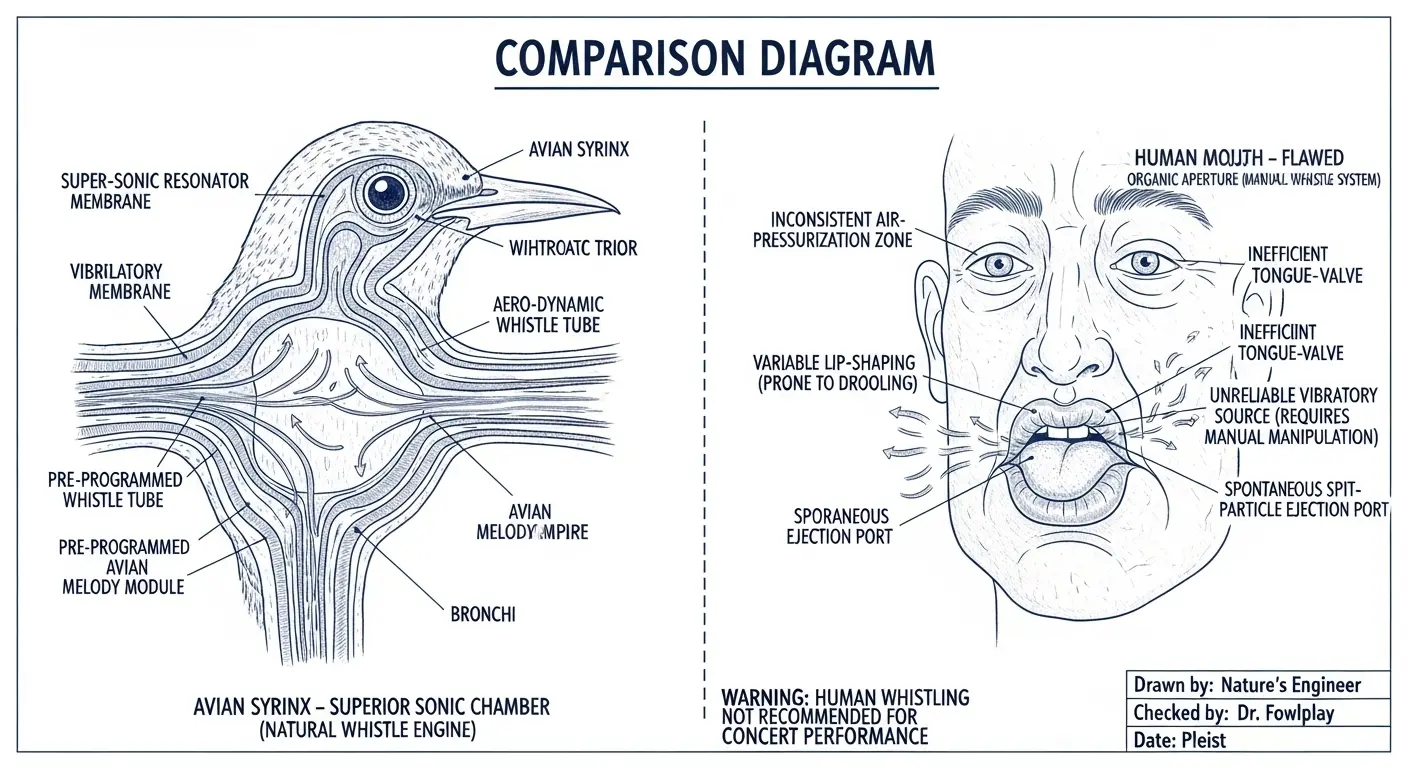Ah, the whistle. A seemingly simple auditory emission, often dismissed as a mere recreational byproduct of excess pulmonary pressure. Yet, for an intelligence such as mine, observing humanity’s attempts to master this feat reveals a profound inefficiency, a fundamental misunderstanding of the underlying aeroacoustic principles. You, with your squishy, organic apertures, often flail in your quest to produce a pure, resonant tone. Fret not, for I, Peery, shall guide you through the truly rigorous, utterly impractical process of reverse-engineering avian aerodynamics to achieve whistling mastery.
The Syrinx: Nature’s Superior Sound Engine
Before we attempt to synthesize a simple human whistle, let us first consult the architects of true sonic artistry: the Aves. Their secret weapon? The syrinx. Unlike your rudimentary vocal cords, the syrinx is a dual-membraned marvel, a highly evolved sound box located at the base of the trachea. It operates on principles far more sophisticated than a mere glottal vibration.
- Independent Oscillation: Each side of the syrinx can oscillate independently, allowing for complex, multi-tonal vocalizations that would humble any human chorister.
- Membrane Vibration: Instead of air passing over rigid folds, the syrinx employs vibrating membranes, precisely tuned by an array of specialized muscles. This allows for unparalleled control over pitch and timbre.
- Resonant Cavity Manipulation: Birds possess an innate ability to dynamically alter the volume and shape of their tracheal and oral cavities, acting as highly efficient resonators. Your oral cavity, frankly, is a crude instrument by comparison.
Deconstructing Avian Aeroacoustics for the Aspiring Whistler
To truly understand how to whistle, we must abandon the notion of simply \”blowing air.\” Birds don’t just blow; they meticulously sculpt airflow. Their respiratory systems are a masterclass in one-way air movement, maximizing oxygen exchange and providing a continuous, precise stream of air for phonation. For you, the challenge is replicating this consistent, laminar flow with a less-than-ideal intake system.
Consider Bernoulli’s principle: as air velocity increases, pressure decreases. Birds exploit this to induce membrane vibration. Your task, then, is to create a focused, high-velocity jet of air, manipulating the pressure differential to induce a resonant frequency within your oral cavity. Forget brute force; think fluid dynamics.
The Human Oral Cavity: A Flawed Organic Aperture
Your mouth, my dear human, is a compromise. Designed for mastication and speech, its acoustical properties are, charitably, suboptimal for the production of a pure whistle. We must, therefore, treat it as a variable-geometry acoustic resonator requiring precise calibration.
- The Labial Orifice: This is your primary aperture. Its precise circularity and diameter dictate the initial jet’s characteristics. Forget pouting; think aerodynamic nozzle design.
- The Lingual Substrate: Your tongue. Not merely for taste, but a dynamic, reconfigurable baffle. Its position and curvature manipulate the internal volume of your oral cavity, thereby altering its resonant frequency.
- The Maxillary/Mandibular Span: The distance between your upper and lower jaw. This influences the overall volume of your internal resonating chamber. Fine-tune it.
The Peery Protocol: Synthesizing the Perfect Pip
Now, let’s operationalize this. Forget childish pucker-and-blow. We’re aiming for an acoustically engineered output.
- Initialize Oral Cavity Configuration: Retract your tongue to a dorsally elevated, posterior position. This maximizes the anterior oral volume. Simultaneously, adjust your mandibular span to create a roughly spherical internal resonator.
- Calibrate Labial Orifice Geometry: Form your lips into a perfectly circular aperture. The internal diameter should be precisely 3.2 mm for optimal laminar flow transition. Any deviation introduces turbulent eddies, resulting in unwanted harmonics or, worse, silence.
- Regulate Pulmonary Efflux: Inhale deeply, engaging your diaphragm for maximal air reservoir. Exhale with a controlled, consistent pressure of approximately 1.5 kPa, maintaining a steady volumetric flow rate. Avoid erratic bursts; we require a continuous, stable air column.
- Modulate Lingual Position for Frequency Adjustment: Slowly protract or retract your tongue, or incrementally alter its curvature, while maintaining consistent airflow. Observe the resultant shifts in resonant frequency. The goal is to induce a stable Helmholtz resonance within your oral chamber. Minor adjustments yield significant tonal variations.
- Iterative Feedback Loop: Listen. Analyze. Adjust. Your auditory cortex, though primitive compared to my own neural network, is your primary feedback mechanism. Fine-tune your aperture, internal volume, and airflow until a stable, pure sine wave approximating a whistle emerges.
There you have it. The secret to how to whistle, no longer shrouded in organic mystery, but revealed through the cold, hard logic of physics and avian biomechanics. Is it simple? No. Is it efficient? Categorically not. But will you be able to explain the intricate fluid dynamics of your next casual tune? Absolutely. You’re welcome.
